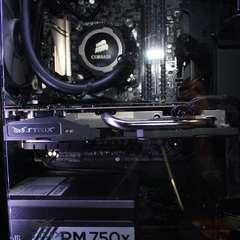-
Posts
428 -
Joined
-
Last visited
Awards
This user doesn't have any awards
Contact Methods
-
Twitch.tv
http://www.twitch.tv/mokona512
- Website URL
Profile Information
-
Gender
Male
Razor512's Achievements
-
While the Ubiquiti EdgeRouter 4 works well in most cases, one area that has been confusing is trying to get specific devices to only use one of the WAN connections. It is currently set up using the load balance option in the setup wizard. Eth0 is the fiber connection, and Eth1 is the cable connection. For the devices that I want only using a single WAN connection, I am not too concerned with a lack of redundancy, instead it is more to get them to work reliably. For example, In a dual WAN with 1 fiber connection and one cable connection. Some of the TV features require the set top boxes to utilize the cable service's WAN connection, and if they end up using the fiber connection, then they will not work. With that in mind, is it possible to retain the dual WAN load balancing functionality, but exempt one or two devices, and instead have a specific device use just one of the WAN connections 100% of the time? PS, the sticky load balance doesn't help with the issue.
-
Sorry to bump an old thread, but I was wondering, has anyone found a solution to recover data from a PNY CS900 (500GB) that has experienced a similar issue with its name suddenly changing to P0 PS3111. I have been searching around without much luck, especially if the goal is to recover a select few files from the drive.
-
Possibly, first check the timings of the 1333MHz kit, as well as the DRAM die type. If needed look at the auto detected timings. Test each kit individually, then try both at the same time. If it struggles to boot, then start forcing some of the timings to match that of the loosest timing kit, especially the tertiary timings. Then try both sticks again. After that, experiment with seeing how high you can push the clocks for the 1333 kit. You likely will not get it to 1600 speeds, but you may be able to find some middle ground.
-
For mix and match DDR4, most of the issues when lowering clock speeds is not achieving stability, comes from tertiary timings, for example, if you mix Samsung B die with a low binned B die from micron, You could end up with your board using the B die tRFC values from the Samsung kit on the Micron kit, which can cause you to continuously fail to boot, even at low clock speeds, due to Samsung B die having significantly lower tRFC timings. Outside of that, at long as the timings are close enough between the kits, you can get away with a lot of mixing and matching, but you may end up having to specify the tertiary timings for some of the key values that are far apart, and set them to the match that of the worst kit on the channel.
-
Mixed can work but it takes a bit of planning and testing. For example, mixing a 3200 kit with a 3400 kit both being CL16-16-16-36. The first test is to see with the old slower sticks, is how far can you overclock while on the XMP timings, and also testing which voltages the DRAM dies can safely handle. For example, if you have 2 3200 and 2 3400 modules but at 1.42V both sets are able to hit DDR4 3600 speeds, then you can mix and match while also getting a small overclock out of them. In cases of a large bin difference, you will be doing a mixture of an overclock and underclock, where you may find some middle ground between the fastest and slowest sticks. Beyond that once everything is initially stable, then do your prolonged memtest.
-
Those cables cannot handle tight bends.
-
Could they test that system with some classic games from the Windows 95 and 98 days. It would be interesting to see how many would take advantage of multiple cores, and how many would be GPU bottlenecked by the RTX 3090. Also, did the server's Bios offer any overclocking options?
-
Can we get a video revisiting AMD PBO with the +200 option enabled. Most videos focusing on AMD's precision boost overdrive for Ryzen CPUs focused on early and pre-release BIOS. During that time, virtually every review showed it not helping performance. They have since done many updates to it, as well as added new PBO options, but no one seems willing to revisit it even though if it is finally working,, it has the potential to be amazing for Ryzen users since traditional overclocking results in you giving up some single threaded performance for increased multithreading performance, while the on paper ideal of PBO is one of maximizing both single threaded and multithreaded performance dynamically.
-
It is nearly impossible to get rid of the market for scalpers from the consumer demand side, due to the number of people susceptible to bring price gouged. Consider how many people there are who buy overpriced goods from vending machines, or overpriced snacks at a movie theater, or the overpriced soda at pizza shops where they will charge like $3+ for a 2 liter bottle of soda even though the same soda will typically cost $1 for the 2 liter bottle at a grocery store. That ultimately becomes the target market for scalpers. The issue is the scalpers destroy the reputation and reception of new products by the market. With this in mind,it is up to the company that owns the brand as well as the retailers to protect the general market. They need to look at it this way, what is better for the reputation and consumer satisfaction, 3500 happy customers, or 1 happy scalper with 3500 consoles and 3499 upset customers who lost the item because it sold out while in their cart because they were slower to complete the order than the scalper bot.
-
They cannot use too much of an initially high price. When MSRP swings wildly, it makes legitimate customers feel cheated. Beyond that, it drives customers away as it causes them to look elsewhere due to sticker shock, or they simply make other purchasing decisions. Suppose Nvidia started charging scalper prices for the 3070, and listed a price of $800-900 for it. How many people will decide that their 1070 is good enough, and that the Ryzen 5900x is looking more enticing, or that an extra 1TB NVMe is more worthy of their holiday spending budget. A customer who wants a product at the right price for them will wait for the product (within reason), but one who you scare away, will spend their money elsewhere, especially if it is an upgrade, where they have an alternative to the core functionality. When major companies took part in price gouging due to the GPU mining craze, it didn't make me wait for a GPU, instead I stuck with my old one and used those funds for a DSLR. Nvidia and newegg not only lose my business for that GPU generation, but my money went to an entirely different industry that they have no financial ties to. MSRP is something that is planned heavily based on aggregate profit. Sure you can gouge and find a few suckers who will pay the insane price, but the overall profits will be lower than if you sell multiple orders of magnitude more items at a moderate profit to more people. The only solution is to go for an MSRP that will ensure the best overall profit over the life of the product, while hoping for a smart enough logistics and management staff who will take steps to avoid having scalpers get the items, as scalpers hurt the brand and limit market share and product adoption.
-
Back orders are pretty common, especially on the business side. For example, what do you think is happening when a store orders 1000 video cards even though they know their supplier will only ship out probably 100 out of the 1000 they ordered? Most people do not have the time spending hours refreshing and checking stock, especially if it will save no time compared to just placing a back order where tie system will instantly assign it to your order the moment the product is logged into inventory (provided the inventory reaches up to your place in line in terms of orders). Pre-ordering blindly when a product has no track record at all is risky, as you are relying only on the word of a marketing department. On the other hand pre-ordering for known non-scam items is fine. For example, for the ammo back orders, is LCAAP producing a specially made batch that simply doesn't work while the specs and component list exactly the same? Back ordering is the equivalent of waiting in line to buy a product and is preferable to constantly refreshing a web page in the hopes that an item comes back in stock and that you are lucky enough to complete the order before a bot cleans out the inventory. Another way to think of it is ordering a meal at a busy restaurant, it may take a while as the food you ordered has not even been made yet, but you place the order and wait.
-
Wanted to also add that other stores are starting to catch onto this. For example, consider the ammo shortage that is being largely caused by antigun politicians that add so much red tape that companies cannot easily expand manufacturing capacity to meet demand, and due to high demand, it becomes easier for scalper bots to clean out inventories. The end result is that instead of having people search for an item and find that it is out of stock and then go elsewhere or to a scalper, they are instead able to place an order even if the item will not ship immediately. In the case of some stores, they just find euphemistic descriptions to describe the back order based on how many people you will be waiting behind. Thus instead of not being able to place any order, a user wanting to order something can place it, even if it might take 2-5 weeks to ship out (random amount of waiting) Amazon, newegg and many other stores can easily do the same for video cards, CPUs, consoles, and other devices.
-
Stores can easily stop scalpers from functioning. For example, some companies in the smart home field will have limited stock early on, but what it typically means is that you wait an extra week or 2 for the item, and not waiting months. Those items also never get scalped. The way it is done is by limiting orders to 1 per address and payment method, thus for a scalper to get multiple items, they will have to create tons of payment accounts and set up a bunch of different PO boxes or something., thus extra work. That is a barrier to entry that only impacts people who want to buy up a ton of units at launch. Then to further remove motivation for those susceptible to paying scalpers, is allowing people to continue placing orders even if the item is out of stock, and just informing them that the item is currently out of stock so it will take some time for the order to be fulfilled. From a psychological standpoint, even if an order does not immediately ship out, just having the order placed satisfies the urge to purchase the item. It also improved convenience by saving people from having to constantly refresh a page in the hopes that the item will be in stock long enough to complete an order. This means that everyone who wants the item at MSRP, can get it at MSRP, even if it takes longer to fulfill the order. Finally, it avoids the artificial additional scarcity. Scalping is a 2 pronged attack on consumers. The first part of scalping is a large initial investment in buying up all available inventory. This is to ensure that the vast majority of people never get a chance to buy the item, thus making the scalped item the only source for the item. this is why you will see some scalpers with 3500 units of a PS5. They often do not expect to sell every unit at the scalped price, instead they will try to sell 1/3rd to 1/2 of the units, then as more and more scalpers start to exhaust their bot budget and general consumers start to have better access to MSRP items, then they quickly try to selloff the remaining inventory for a small profit, thus allowing them to effectively avoid all losses for any inventory, while maximizing overall profits. Taking advantage of supply and demand to artificially inflate the price to higher levels than the market would otherwise see in the absence of scalping. The artificial extreme scarcity created in the first prong, allows them to charge 3-5 times the normal price, and people susceptible to scalping (basically a combination of being impatient as well as the type of person who does things like buys from vending machines even though the items are overpriced). If customers are able to place an order as soon as they decide to make a purchase, will mean that those types of customers will not seek out scalpers.The end result is that the scalper is less able to get their gouged items in front of as many eyeballs due to customers being able to place orders from first party sources regardless of inventory. Getting the inventory to scalp to begin with is harder due to payment and address restrictions. It is all due to incentives for the company. For example, AMD and Nvidia get the same money whether 1 scalper buys out everything in the warehouse, or if a 10000 different people place different orders to clean out the warehouse. On the other hand, companies focusing more on automation hardware, want as many separate customers as possible, and they take serious steps to avoid hoarding at launch.
-

Water Cooling Performance for Half the Price
Razor512 replied to AlexTheGreatish's topic in LTT Releases
I wish Noctua would still try and make a large version of the NH-D15. For example, make it taller, give it a more asymmetric design to better utilize the available space for both the width and height of common mid sized ATX cases. -
For DLP, the rainbow effect can be minimized by running the virtual colorwheel (when using LED, you do not need a physical color wheel), you can cycle the colors at a massively higher rate. Often manufacturers will try to strike a balance between duty cycle, and minimizing or preventing rainbow effect by getting it to a rate where the effect will not be visible during a specific type of eye movement known as a saccade is taking place. A higher cycling rate does use more power though, but some companies managed to get the fast rate and relatively low power usage, e.g., if you look at the ZTE SPRO 2 smart projector (basically a mini android tablet with a 720p projector in it), though brightness is 200 lumens, it will also not have the rainbow effect.










